Tapir
| Tapir Temporal range: 55–0Ma Early Eocene – Recent | |
|---|---|
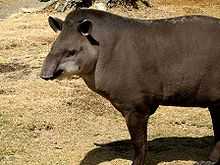 | |
| Brazilian tapir | |
| Scientific classification | |
| Kingdom: | Animalia |
| Phylum: | Chordata |
| Class: | Mammalia |
| Order: | Perissodactyla |
| Superfamily: | Tapiroidea |
| Family: | Tapiridae Gray, 1821 |
| Genus: | Tapirus Brünnich, 1772 |
| Species | |
|
Tapirus bairdii | |
A tapir (/ˈteɪpər/ TAY-pər or /təˈpɪər/ tə-PEER) is a large herbivorous mammal, similar in shape to a pig, with a short, prehensile snout. Tapirs inhabit jungle and forest regions of South America, Central America, and Southeastern Asia. The five extant species of tapirs are the Brazilian tapir, the Malayan tapir, the Baird's tapir, the kabomani tapir, and the mountain tapir. The four species that have been evaluated (the Brazilian, Malayan, Baird's and mountain tapir) have all been classified as endangered or vulnerable. Their closest relatives are the other odd-toed ungulates, including horses and rhinoceroses.
Species
Five extant species within one extant genus are widely recognized. Four are in Central and South America whilst the fifth is in Asia.[1] (Some authors describe more, and a number are extinct):
- Baird's tapir, Tapirus bairdii
- Brazilian tapir (also called the South American or lowland tapir), Tapirus terrestris
- Kabomani tapir, Tapirus kabomani[1]
- Malayan tapir, Tapirus indicus
- Mountain tapir, Tapirus pinchaque
- Tapirus californicus †
- Tapirus copei †
- Tapirus merriami †
- Tapirus polkensis †
- Tapirus veroensis †
Hybrids
Hybrids of the Baird's and the Brazilian tapirs were bred at the San Francisco Zoo around 1969 and later produced a backcross second generation.[2]
General appearance

Size varies between types, but most tapirs are about 2 m (6.6 ft) long, stand about 1 m (3 ft) high at the shoulder, and weigh between 150 and 300 kg (330 and 700 lb). Their coats are short and range in color from reddish-brown to grey to nearly black, with the notable exceptions of the Malayan tapir, which has a white, saddle-shaped marking on its back, and the mountain tapir, which has longer, woolly fur. All tapirs have oval, white-tipped ears, rounded, protruding rumps with stubby tails, and splayed, hooved toes, with four toes on the front feet and three on the hind feet, which help them to walk on muddy and soft ground. Baby tapirs of all types have striped-and-spotted coats for camouflage. Females have a single pair of mammary glands,[3] and males have long penises relative to their body size.[4][5][6][7][8]
Physical characteristics

The proboscis of the tapir is a highly flexible organ, able to move in all directions, allowing the animals to grab foliage that would otherwise be out of reach. Tapirs often exhibit the flehmen response, a posture in which they raise their snouts and show their teeth to detect scents. This response is frequently exhibited by bulls sniffing for signs of other males or females in oestrus in the area. The length of the proboscis varies among species; Malayan tapirs have the longest snouts and Brazilian tapirs have the shortest.[9] The evolution of tapir proboscises, made up almost entirely of soft tissues rather than bony internal structures, gives the Tapiridae skull a unique form in comparison to other perissodactyls, with a larger sagittal crest, orbits positioned more rostrally, a posteriorly telescoped cranium, and a more elongated and retracted nasoincisive incisure.[10][11]
-
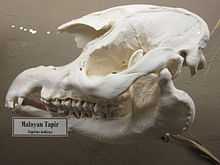
Malayan Tapir skull
-

Baird's Tapir skull
-

Brazilian Tapir skull
-
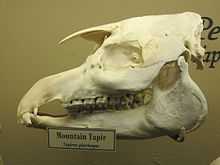
Mountain Tapir skull
Tapirs have brachyodont, or low-crowned, teeth that lack cementum. Their dental formula is
| Dentition |
|---|
| 3.1.4.3 |
| 3.1.3-4.3 |
totalling 42 to 44 teeth; this dentition is closer to that of equids, which may differ by one less canine, than their other perissodactyl relatives, rhinoceroses.[12][13] Their incisors are chisel-shaped, with the third large, conical upper incisor separated by a short gap from the considerably smaller canine. A much longer gap is found between the canines and premolars, the first of which may be absent.[14] Tapirs are lophodonts, and their cheek teeth have distinct lophs (ridges) between protocones, paracones, metacones and hypocones.[15][16]
Tapirs have brown eyes, often with a bluish cast to them, which has been identified as corneal cloudiness, a condition most commonly found in Malayan tapirs. The exact etiology is unknown, but the cloudiness may be caused by excessive exposure to light or by trauma.[17][18] However, the tapir's sensitive ears and strong sense of smell help to compensate for deficiencies in vision.
Tapirs have simple stomachs and are hindgut fermenters that ferment digested food in a large cecum.[19]
Life cycle
Young tapirs reach sexual maturity between three and five years of age, with females maturing earlier than males.[20] Under good conditions, a healthy female tapir can reproduce every two years; a single youngster, called a calf, is born after a gestation of about 13 months.[21] The natural lifespan of a tapir is approximately 25 to 30 years, both in the wild and in zoos.[22] Apart from mothers and their young offspring, tapirs lead almost exclusively solitary lives.
Behavior

Although they frequently live in dryland forests, tapirs with access to rivers spend a good deal of time in and under the water, feeding on soft vegetation, taking refuge from predators, and cooling off during hot periods. Tapirs near a water source will swim, sink to the bottom, and walk along the riverbed to feed, and have been known to submerge themselves under water to allow small fish to pick parasites off their bulky bodies.[23] Along with freshwater lounging, tapirs often wallow in mud pits, which also help to keep them cool and free of insects.
In the wild, the tapir's diet consists of fruit, berries, and leaves, particularly young, tender growth. Tapirs will spend many of their waking hours foraging along well-worn trails, snouts to the ground in search of food. Baird's tapirs have been observed to eat around 40 kg (85 lb) of vegetation in one day.[24]
Tapirs are largely nocturnal and crepuscular, although the smaller mountain tapir of the Andes is generally more active during the day than its congeners. They have monocular vision.
Copulation may occur in or out of water, and in captivity, mating pairs will often copulate multiple times during oestrus.[25][26] Intromission lasts between 10 and 20 minutes.[27]


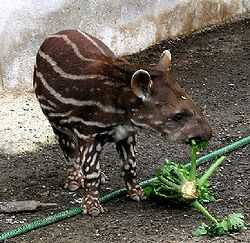
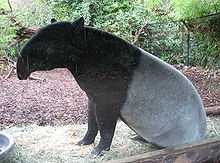
Habitat, predation, and vulnerability
Adult tapirs are large enough to have few natural predators, and the thick skin on the backs of their necks helps to protect them from threats such as jaguars, crocodiles, anacondas, and tigers. The creatures are also able to run fairly quickly, considering their size and cumbersome appearance, finding shelter in the thick undergrowth of the forest or in water. Hunting for meat and hides has substantially reduced their numbers and, more recently, habitat loss has resulted in the conservation watch-listing of all four species: both the Brazilian tapir and the Malayan tapir are classified as vulnerable; and the Baird's tapir and the mountain tapir are endangered.
Evolution and natural history
The first tapirids, such as Heptodon, appeared in the early Eocene of North America.[28] They appeared very similar to modern forms, but were about half the size, and lacked the proboscis. The first true tapirs appeared in the Oligocene. By the Miocene, such genera as Miotapirus were almost indistinguishable from the extant species. Asian and American tapirs were believed to have diverged around 20 to 30 million years ago; tapirs later migrated from North America to South America around 3 million years ago, as part of the Great American Interchange.[29] For much of their history, tapirs were spread across the Northern Hemisphere, where they became extinct as recently as 10,000 years ago.[30] T. merriami, T. veroensis, T. copei, and T. californicus became extinct during the Pleistocene in North America. The giant tapir Megatapirus survived until about 4,000 years ago in China.
Approximate divergence times based on a 2013 analysis of mtDNA sequences are 0.5 Ma for T. kabomani and the T. terrestris–T. pinchaque clade, 5 Ma for T. bairdii and the three South American tapirs and 9 Ma for the T. indicus branching.[31] T. pinchaque arises from within a paraphyletic complex of T. terrestris populations.[31]
| Tapirus |
| |||||||||||||||||||||||||||||||||
| |
The tapir may have evolved from the paleothere Hyracotherium (once thought to be a primitive horse).[32]
Genetics
The species of tapir have the following chromosomal numbers:
| Malayan tapir, T. indicus | 2n = 52 |
|---|---|
| Mountain tapir, T. pinchaque | 2n = 76 |
| Baird's tapir, T. bairdii | 2n = 80 |
| Brazilian tapir, T. terrestris | 2n = 80 |
The Malayan tapir, the species most isolated geographically from the rest of the genus, has a significantly smaller number of chromosomes and has been found to share fewer homologies with the three types of American tapirs. A number of conserved autosomes (13 between karyotypes of the Baird's tapir and Brazilian tapir, and 15 between the Baird's and mountain tapir) have also been found in the American species that are not found in the Asian animal. However, geographic proximity is not an absolute predictor of genetic similarity; for instance, G-banded preparations have revealed Malayan, Baird's and Brazilian tapirs have identical X chromosomes, while mountain tapirs are separated by a heterochromatic addition/deletion.[33]
Lack of genetic diversity in tapir populations has become a major source of concern for conservationists. Habitat loss has isolated already small populations of wild tapirs, putting each group in greater danger of dying out completely. Even in zoos, genetic diversity is limited; all captive mountain tapirs, for example, are descended from only two founder individuals.[34]
Conservation
A number of conservation projects have been started around the world. The Tapir Specialist Group, a unit of the IUCN Species Survival Commission, strives to conserve biological diversity by stimulating, developing, and executing practical programs to study, save, restore, and manage the four species of tapir and their remaining habitats in Central and South America and Southeast Asia.[35]
The Baird's Tapir Project of Costa Rica is the longest ongoing tapir project in the world, having started in 1994. It involves placing radio collars on tapirs in Costa Rica's Corcovado National Park to study their social systems and habitat preferences.[36]
Attacks on humans
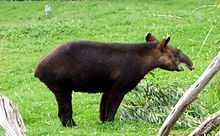
Tapirs are generally shy, but when scared, they can defend themselves with their very powerful jaws. In 1998, a zookeeper in Oklahoma City was mauled and had an arm severed after opening the door to a female tapir's enclosure to push food inside. (The tapir's two-month-old baby also occupied the cage at the time.)[37] In 2006, Carlos Manuel Rodriguez Echandi (who was then the Costa Rican Environmental Minister) became lost in the Corcovado National Park and was found by a search party with a "nasty bite" from a wild tapir.[38] However, such examples are rare; for the most part, tapirs are likely to avoid confrontation in favour of running from predators, hiding, or, if possible, submerging themselves in nearby water until a threat is gone.[39]
Frank Buck wrote about an attack by a tapir in 1926, which he described in his book, Bring 'Em Back Alive.[40]
Cultural references
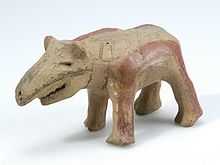
In Chinese, Korean and Japanese, the tapir is named after a beast from Chinese mythology, known in Japanese mythology as the Baku (獏 or 貘). A feature of this mythical creature is a snout like that of an elephant. In Chinese and Japanese folklore, tapirs, like their chimerical counterpart, are thought to eat people's nightmares. In Chinese, the name of this beast, subsequently the name of the tapir, is mò in Mandarin (貘) and mahk in Cantonese (貘). The Korean equivalent is maek (Hangul: 맥, Hanja: 貘 [출처] 테이퍼 [貘, tapir ] ), while it is called baku (バク) in Japanese.
In the prehistoric sequences of the science fiction film 2001: A Space Odyssey, tapirs appear alongside primitive hominids in Africa. There is no evidence indicating tapirs ever existed in Africa, so it is likely they were added simply for their "prehistoric" appearance.[41]
References
- ↑ 1.0 1.1 Hance, Jeremy. "Scientists make one of the biggest animal discoveries of the century: a new tapir". Mongabay. Retrieved 17 December 2013.
- ↑ Pictures of T. bairdii x T. terrestris cross taken by Sheryl Todd, The Tapir Gallery, web site of the Tapir Preservation Fund
- ↑ Gorog, A. 2001. Tapirus terrestris, Animal Diversity Web. Retrieved June 19, 2006.
- ↑ RS, G. Hickey. "TAPIR PENIS." Nature Australia 25.8 (1997): 10-11.
- ↑ Endangered Wildlife and Plants of the World. Marshall Cavendish. 1 January 2001. pp. 1460–. ISBN 978-0-7614-7194-3. Retrieved 23 January 2013.
- ↑ M. R. N. Prasad (1974). Männliche Geschlechtsorgane. Walter de Gruyter. pp. 119–. ISBN 978-3-11-004974-9. Retrieved 23 January 2013.
- ↑ Daniel W. Gade (1999). Nature & Culture in the Andes. Univ of Wisconsin Press. pp. 125–. ISBN 978-0-299-16124-8. Retrieved 4 March 2013.
- ↑ Jeffrey Quilter (1 April 2004). Cobble Circles and Standing Stones: Archaeology at the Rivas Site, Costa Rica. University of Iowa Press. pp. 181–. ISBN 978-1-58729-484-6. Retrieved 4 March 2013.
- ↑ Witmer, Lawrence; Sampson, Scott D.; Solounias, Nikos (1999). "The proboscis of tapirs (Mammalia: Perissodactyla): a case study in novel narial anatomy" (PDF). Journal of Zoology: 251.
- ↑ Witmer, page 249
- ↑ Colbert, Dr. Matthew, 2002, Tapirus terrestris (On-line), Digital Morphology. Retrieved June 20, 2006.
- ↑ Ballenger, L. and P. Myers. 2001. "Tapiridae" (On-line), Animal Diversity Web. Retrieved June 20, 2006.
- ↑ Huffman, Brent. Order Perissodactyla at Ultimate Ungulate
- ↑ "PERISSODACTYLA." LoveToKnow 1911 Online Encyclopedia
- ↑ Myers, P., R. Espinosa, C. S. Parr, T. Jones, G. S. Hammond, and T. A. Dewey. 2006. The Diversity of Cheek Teeth. The Animal Diversity Web (online). Retrieved June 20, 2006.
- ↑ Myers, P., R. Espinosa, C. S. Parr, T. Jones, G. S. Hammond, and T. A. Dewey. 2006. The Basic Structure of Cheek Teeth. The Animal Diversity Web (online). Retrieved June 20, 2006.
- ↑ Tapirs Described, the Tapir Gallery
- ↑ Janssen, Donald L., DVM, Dipl ACZM, Bruce A. Rideout, DVM, PhD, Dipl ACVP, Mark E. Edwards, PhD. "Medical Management of Captive Tapirs (Tapirus sp.)." 1996 American Association of Zoo Veterinarians Proceedings. Nov 1996. Puerto Vallarta, Mexico. Pp. 1-11
- ↑ Eisenberg, J.F. et al. (1990). "Tapirs". In Parker, S.P. Grzimek's Encyclopedia of Mammals, Vol. 4. New York: McGraw-Hill Publishing. pp. 598–620. ISBN 0-07-909508-9.
- ↑ "Woodland Park Zoo Animal Fact Sheet: Malayan Tapir ''(Tapirus indicus)''". Zoo.org. Retrieved 2009-11-02.
- ↑ Tapir | San Diego Zoo Animals.
- ↑ Morris, Dale. "Face to face with big nose." BBC Wildlife, March 2005, page 37.
- ↑ Morris, page 36.
- ↑ TPF News, Tapir Preservation Fund, Vol. 4, No. 7, July 2001. See section on study by Charles Foerster.
- ↑ "Minimum Husbandry Standards: Tapiridae (tapirs)". Retrieved 2009-11-02.
- ↑ Animal Diversity Web fact sheet on Tapirus terrestris
- ↑ Catharine E. Bell (2001). Encyclopedia of the World's Zoos. Taylor & Francis. pp. 1205–. ISBN 978-1-57958-174-9. Retrieved 23 January 2013.
- ↑ Ballenger, L.; Myers, P. (2001). "Family Tapiridae". Animal Diversity Web. Archived from the original on 2013-04-13. Retrieved 2014-05-11.
- ↑ Ashley, M.V.; Norman, J.E.; Stross, L. (1996). "Phylogenetic analysis of the perissodactyl family tapiridae using mitochondrial cytochrome c oxidase (COII) sequences". Mammal Evolution 3 (4): 315–326. doi:10.1007/BF02077448.
- ↑ Palmer, D., ed. (1999). The Marshall Illustrated Encyclopedia of Dinosaurs and Prehistoric Animals. London: Marshall Editions. p. 261. ISBN 1-84028-152-9.
- ↑ 31.0 31.1 Cozzuol, M. A.; Clozato, C. L.; Holanda, E. C.; Rodrigues, F. V. H. G.; Nienow, S.; De Thoisy, B.; Redondo, R. A. F.; Santos, F. C. R. (2013). "A new species of tapir from the Amazon". Journal of Mammalogy 94 (6): 1331. doi:10.1644/12-MAMM-A-169.1.
- ↑ "Florida Museum of Natural History Fact Page". Flmnh.ufl.edu. Retrieved 2009-11-02.
- ↑ Houck, M.L.; Kingswood, S.C.; Kumamoto, A.T. (2000). "Comparative cytogenetics of tapirs, genus Tapirus (Perissodactyla, Tapiridae)". Cytogenetics and Cell Genetics 89: 110–115. doi:10.1159/000015587.
- ↑ Mountain Tapir Conservation at the Cheyenne Mountain Zoo
- ↑ "About the Tapir Specialist Group". Tapirs.org. Retrieved 2009-11-02.
- ↑ "Baird's Tapir Project of Costa Rica". Savetapirs.org. 2009-02-18. Retrieved 2009-11-02.
- ↑ "Woman's arm bitten off in zoo attack", Associated Press report by Jay Hughes, 20 Nov 1998
- ↑ "Interview with Carlos Manuel Rodriguez Echandi", IUCN Tapir Specialist Group 2006
- ↑ Goudot, Justin. "Nouvelles observations sur le Tapir Pinchaque (Recent Observations on the Tapir Pinchaque)," Comptes Rendus, Paris 1843, vol. xvi, pages 331-334. Available online with English translation by Tracy Metz. Report contains accounts of wild mountain tapirs shying away from human contact at salt deposits after being hunted, and hiding.
- ↑ Buck, Frank (2006-05-30). Bring 'em Back Alive: The Best of ... - Google Books. Books.google.com. ISBN 978-0-89672-582-9. Retrieved 2009-11-02.
- ↑ Tapirs in "2001: A Space Odyssey", The Tapir Gallery.
External links
| Wikimedia Commons has media related to Tapirus terrestris. |
- IUCN/SSC Tapir Specialist Group
- The Tapir Gallery at The Tapir Preservation Fund website
- World Tapir Day website
- Baird's Tapir Project of Costa Rica
| ||||||||||||||||||||||||||||||||||||||||||||||||||||
